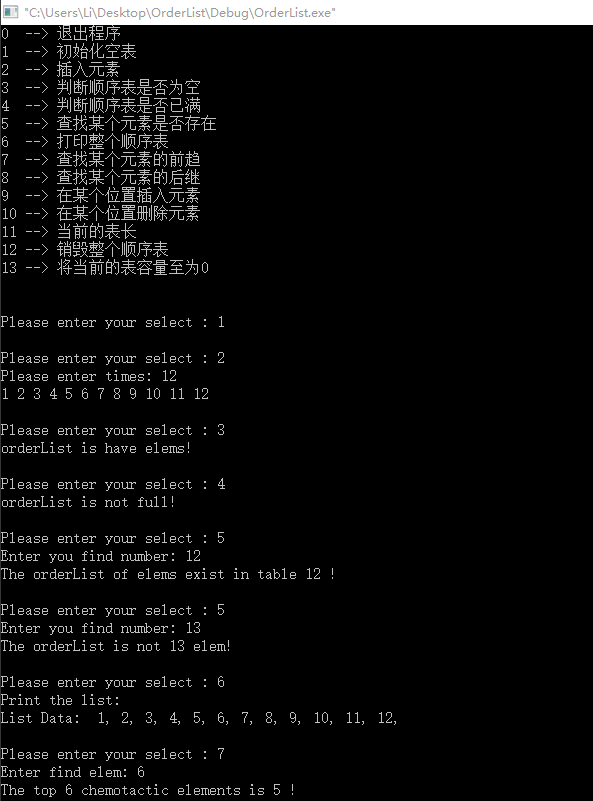| 版权声明:本文为博主原创文章,未经博主允许不得转载。
从这节开始,以后的每一篇博文均会只描述一种结构。这节要解决的是有关顺序表的问题,下面就是一些顺序表的基本的知识点:
1. 顺序表其实就是线性表的一种,它除开始节点和结束节点之外的其他节点,均有且只有一个直接前趋和一个直接后继,开始
节点只有一个后继节点,结束节点只有一个前趋节点。
2. 用顺序存储方法存储的线性表就称为顺序表。
3. 顺序存储方法就是将表的节点按逻辑上的次序依次的存放在一组连续的内存单元中,这里是指在逻辑上连续排列,在物理的
存储单元上也连续的排列。
4. 在顺序表中,因为顺序表的每一个单元均是同种类型的数据,因此它们的每一个的节点的内存单元的空间是一样大的,我们
可以根据下面的公式,来求得某个节点的存储地址:

>>.分步代码
1>. 顺序表的结构体定义(代码如下):
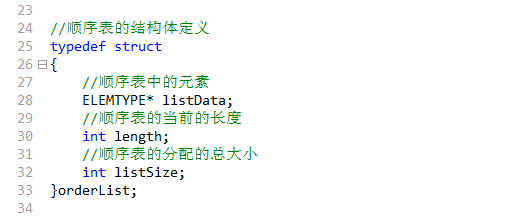
在结构体中,有顺序表的当前容量,有顺序表的首地址listData,还要有顺序表的总大小listSize。
2>. 顺序表的初始化(代码如下):
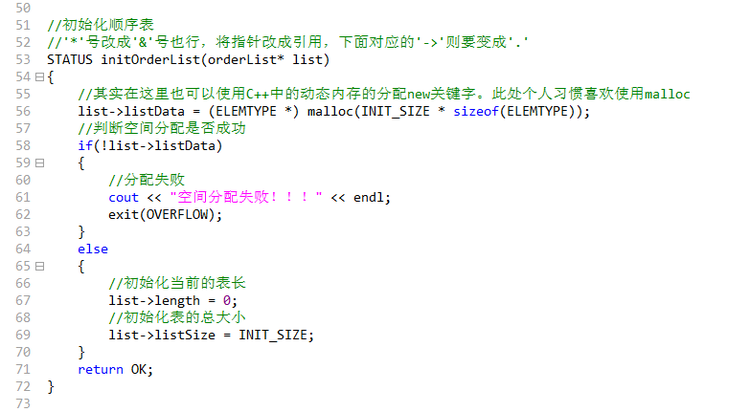
3>. 顺序表的表长(代码如下):

4>. 插入元素
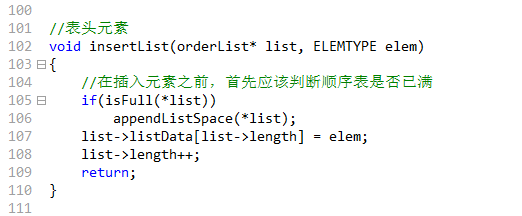
5>. 追加空间
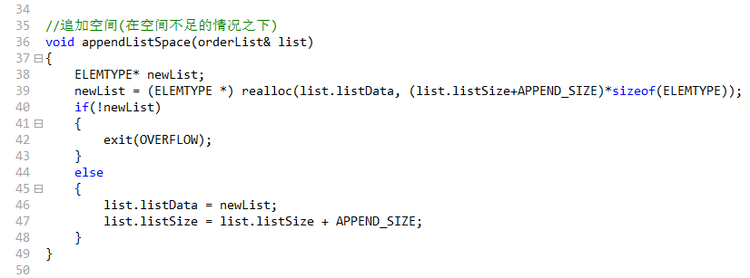
6>. 判断顺序表是否为空

7>. 判断顺序表是否已满

8>. 查找某个元素

9>. 打印顺序表
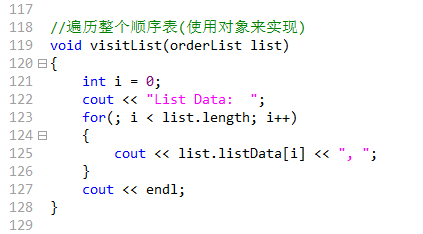
10>. 查找某个元素的前趋
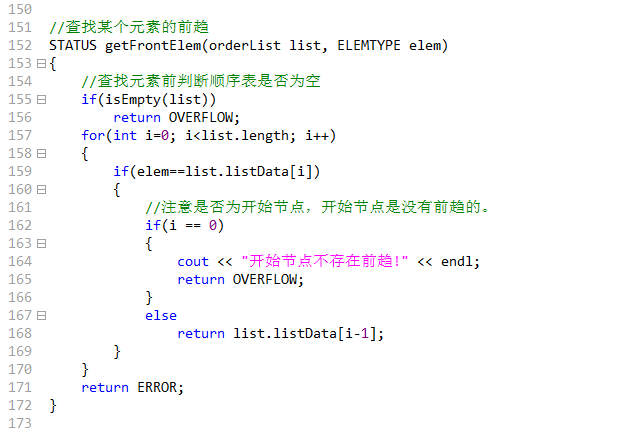
11>. 查找某个元素的后继
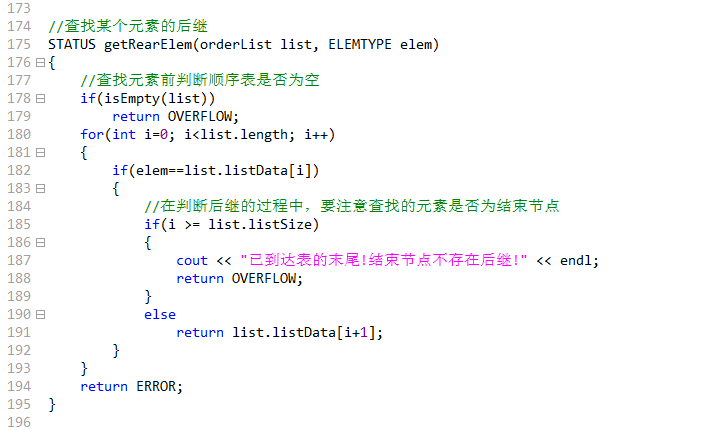
12>. 在pos位置插入元素

13>. 在pos位置删除元素
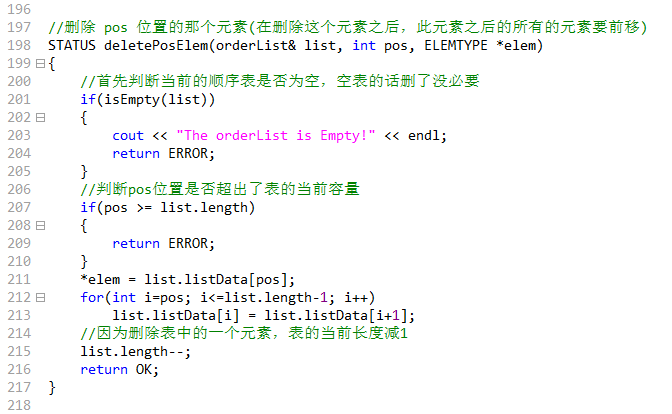
14>. 销毁整个顺序表

15>. 将当前表长至为0

>>.完整代码
1 /****************************************************** 2 * 数据结构-顺序表 * 3 * * 4 * 2016/7/25 * 5 * by Lipei * 6 ******************************************************/ 7 8 #include <iostream> 9 #include <stdio.h> 10 #include <stdlib.h> 11 using namespace std; 12 13 #define OK 1 14 #define ERROR 0 15 #define OVERFLOW -1 16 //顺序表初次分配空间的大小 17 #define INIT_SIZE 100 18 //顺序表追加空间的大小 19 #define APPEND_SIZE 10 20 21 typedef int STATUS; 22 typedef int ELEMTYPE; 23 24 //顺序表的结构体定义 25 typedef struct 26 { 27 //顺序表中的元素 28 ELEMTYPE* listData; 29 //顺序表的当前的长度 30 int length; 31 //顺序表的分配的总大小 32 int listSize; 33 }orderList; 34 35 //追加空间(在空间不足的情况之下) 36 void appendListSpace(orderList& list) 37 { 38 ELEMTYPE* newList; 39 newList = (ELEMTYPE *) realloc(list.listData, (list.listSize+APPEND_SIZE)*sizeof(ELEMTYPE)); 40 if(!newList) 41 { 42 exit(OVERFLOW); 43 } 44 else 45 { 46 list.listData = newList; 47 list.listSize = list.listSize + APPEND_SIZE; 48 } 49 } 50 51 //初始化顺序表 52 //'*'号改成'&'号也行,将指针改成引用,下面对应的'->'则要变成'.' 53 STATUS initOrderList(orderList* list) 54 { 55 //其实在这里也可以使用C++中的动态内存的分配new关键字。此处个人习惯喜欢使用malloc 56 list->listData = (ELEMTYPE *) malloc(INIT_SIZE * sizeof(ELEMTYPE)); 57 //判断空间分配是否成功 58 if(!list->listData) 59 { 60 //分配失败 61 cout << "空间分配失败!!!" << endl; 62 exit(OVERFLOW); 63 } 64 else 65 { 66 //初始化当前的表长 67 list->length = 0; 68 //初始化表的总大小 69 list->listSize = INIT_SIZE; 70 } 71 return OK; 72 } 73 74 //判断顺序表是否为空 75 bool isEmpty(orderList& list) 76 { 77 //如果顺序表的当前长度为0,则说明顺序表为空 78 if(list.length == 0) 79 { 80 return true; 81 } 82 else 83 { 84 return false; 85 } 86 } 87 88 //判断顺序表是否已满 89 bool isFull(orderList& list) 90 { 91 //如果顺序表的当前长度已经等于了顺序表的大小,则表明顺序表已满 92 if(list.length >= list.listSize) 93 { 94 return true; 95 } 96 else 97 { 98 return false; 99 } 100 } 101 102 //表头元素 103 void insertList(orderList* list, ELEMTYPE elem) 104 { 105 //在插入元素之前,首先应该判断顺序表是否已满 106 if(isFull(*list)) 107 appendListSpace(*list); 108 list->listData[list->length] = elem; 109 list->length++; 110 return; 111 } 112 113 //取得当前顺序表的容量(及在当前的情况下,顺序表中有几个元素) 114 STATUS getListLength(orderList* list) 115 { 116 return list->length; 117 } 118 119 //遍历整个顺序表(使用对象来实现) 120 void visitList(orderList list) 121 { 122 int i = 0; 123 cout << "List Data: "; 124 for(; i < list.length; i++) 125 { 126 cout << list.listData[i] << ", "; 127 } 128 cout << endl; 129 } 130 131 //查找某个元素是否存在 132 STATUS findElem(orderList* list, ELEMTYPE elem) 133 { 134 //在查找元素之前,判断顺序表是否为空 135 if(isEmpty(*list)) 136 { 137 cout << "orderList is empty!" << endl; 138 } 139 int i; 140 for(i=0; i<list->length; i++) 141 { 142 if(list->listData[i]==elem) 143 { 144 cout << "The orderList of elems exist in table " << list->listData[i] << " !" << endl; 145 return OK; 146 } 147 } 148 cout << "The orderList is not " << elem << " elem!" << endl; 149 return ERROR; 150 } 151 152 //查找某个元素的前趋 153 STATUS getFrontElem(orderList list, ELEMTYPE elem) 154 { 155 //查找元素前判断顺序表是否为空 156 if(isEmpty(list)) 157 return OVERFLOW; 158 for(int i=0; i<list.length; i++) 159 { 160 if(elem==list.listData[i]) 161 { 162 //注意是否为开始节点,开始节点是没有前趋的。 163 if(i == 0) 164 { 165 cout << "开始节点不存在前趋!" << endl; 166 return OVERFLOW; 167 } 168 else 169 return list.listData[i-1]; 170 } 171 } 172 return ERROR; 173 } 174 175 //查找某个元素的后继 176 STATUS getRearElem(orderList list, ELEMTYPE elem) 177 { 178 //查找元素前判断顺序表是否为空 179 if(isEmpty(list)) 180 return OVERFLOW; 181 for(int i=0; i<list.length; i++) 182 { 183 if(elem==list.listData[i]) 184 { 185 //在判断后继的过程中,要注意查找的元素是否为结束节点 186 if(i >= list.listSize) 187 { 188 cout << "已到达表的末尾!结束节点不存在后继!" << endl; 189 return OVERFLOW; 190 } 191 else 192 return list.listData[i+1]; 193 } 194 } 195 return ERROR; 196 } 197 198 //删除 pos 位置的那个元素(在删除这个元素之后,此元素之后的所有的元素要前移) 199 STATUS deletePosElem(orderList& list, int pos, ELEMTYPE *elem) 200 { 201 //首先判断当前的顺序表是否为空,空表的话删了没必要 202 if(isEmpty(list)) 203 { 204 cout << "The orderList is Empty!" << endl; 205 return ERROR; 206 } 207 //判断pos位置是否超出了表的当前容量 208 if(pos >= list.length) 209 { 210 return ERROR; 211 } 212 *elem = list.listData[pos]; 213 for(int i=pos; i<=list.length-1; i++) 214 list.listData[i] = list.listData[i+1]; 215 //因为删除表中的一个元素,表的当前长度减1 216 list.length--; 217 return OK; 218 } 219 220 //pos 位置插入元素(在pos元素之后插入元素后,pos位置之后的所有的元素要后移) 221 STATUS addPosElem(orderList& list, int pos, ELEMTYPE elem) 222 { 223 //在插入元素之前,判断表是否已满,满了就追加空间 224 if(isFull(list)) 225 appendListSpace(list); 226 //判断pos位置是否合理,如果pos位置大于表的当前的容量的话, 227 //是不能向表中插入的(因为这样就不是顺序表了)! 228 if(pos >= list.length) 229 return ERROR; 230 //在插入元素前,首先要将pos位置后的元素全部后移一位。将pos位置腾空出来. 231 for(int i=list.length-1; i>=pos; i--) 232 list.listData[i+1] = list.listData[i]; 233 list.listData[pos] = elem; 234 list.length++; 235 return OK; 236 } 237 238 //销毁整个顺序表 239 void destoryList(orderList* list) 240 { 241 //首先将顺序表的当前容量设为0 242 list->length = 0; 243 free(list->listData); 244 } 245 246 //将表的当前容量设为0 247 void toZeroLength(orderList* list) 248 { 249 list->length = 0; 250 } 251 252 void DisplayFunc() 253 { 254 cout << "0 --> 退出程序" << endl; 255 cout << "1 --> 初始化空表" << endl; 256 cout << "2 --> 插入元素" << endl; 257 cout << "3 --> 判断顺序表是否为空" << endl; 258 cout << "4 --> 判断顺序表是否已满" << endl; 259 cout << "5 --> 查找某个元素是否存在" << endl; 260 cout << "6 --> 打印整个顺序表" << endl; 261 cout << "7 --> 查找某个元素的前趋" << endl; 262 cout << "8 --> 查找某个元素的后继" << endl; 263 cout << "9 --> 在某个位置插入元素" << endl; 264 cout << "10 --> 在某个位置删除元素" << endl; 265 cout << "11 --> 当前的表长" << endl; 266 cout << "12 --> 销毁整个顺序表" << endl; 267 cout << "13 --> 将当前的表容量至为0" << endl << endl << endl; 268 } 269 270 int main(void) 271 { 272 DisplayFunc(); 273 int n; 274 int time = 0; 275 int i = 0; 276 int elem; 277 int flag; 278 int pos; 279 int length; 280 orderList list; 281 while(1) 282 { 283 cout << "Please enter your select : "; 284 cin >> n; 285 286 switch(n) 287 { 288 case 1: 289 initOrderList(&list); 290 cout << endl; 291 break; 292 case 2: 293 cout << "Please enter times: "; 294 cin >> time; 295 for(i=0; i<time; i++) 296 { 297 cin >> elem; 298 insertList(&list, elem); 299 } 300 cout << endl; 301 break; 302 case 3: 303 if(isEmpty(list)) 304 cout << "orderList is empty!" << endl; 305 else 306 cout << "orderList is have elems!" << endl; 307 cout << endl; 308 break; 309 case 4: 310 if(isFull(list)) 311 cout << "orderList is full!" << endl; 312 else 313 cout << "orderList is not full!" << endl; 314 cout << endl; 315 break; 316 case 5: 317 cout << "Enter you find number: "; 318 cin >> elem; 319 findElem(&list, elem); 320 cout << endl; 321 break; 322 case 6: 323 cout << "Print the list: " << endl; 324 visitList(list); 325 cout << endl; 326 break; 327 case 7: 328 cout << "Enter find elem: "; 329 cin >> elem; 330 flag = getFrontElem(list, elem); 331 if(flag==OVERFLOW || flag==ERROR) 332 cout << "Is not find, error!" << endl; 333 else 334 cout << "The top " << elem << " chemotactic elements is " << flag << " !" << endl; 335 cout << endl; 336 break; 337 case 8: 338 cout << "Enter find elem: "; 339 cin >> elem; 340 flag = getRearElem(list, elem); 341 if(flag==OVERFLOW || flag==ERROR) 342 cout << "Is not find, error!" << endl; 343 else 344 cout << "The elem " << elem << " subsequent element of " << flag << " !" << endl; 345 cout << endl; 346 break; 347 case 9: 348 cout << "Please enter Location: "; 349 cin >> pos; 350 cout << "Please enter add elem: "; 351 cin >> elem; 352 flag = addPosElem(list, pos, elem); 353 if(flag==OK) 354 { 355 //delect success 356 cout << pos << " location is add successful! The add orderList elem is " << elem << " ." << endl; 357 cout << "Print the list: " << endl; 358 visitList(list); 359 } 360 else 361 { 362 cout << "Error! add failure." << endl; 363 } 364 cout << endl; 365 break; 366 case 10: 367 cout << "Please enter Location: "; 368 cin >> pos; 369 flag = deletePosElem(list, pos, &elem); 370 if(flag==OK) 371 { 372 //delect success 373 cout << pos << " location is delete successful! The delete orderList elem is " << elem << " ." << endl; 374 cout << "Print the list: " << endl; 375 visitList(list); 376 } 377 else 378 { 379 cout << "Error! delete failure." << endl; 380 } 381 cout << endl; 382 break; 383 case 11: 384 length = getListLength(&list); 385 cout << "The orderList length is " << length << " ." << endl; 386 cout << endl; 387 break; 388 case 12: 389 destoryList(&list); 390 cout << "The orderList destory is successful!" << endl; 391 cout << endl; 392 break; 393 case 13: 394 toZeroLength(&list); 395 cout << "The orderList to list size of zero is successful!" << endl; 396 cout << endl; 397 break; 398 case 0: 399 cout << "Progarm is exit, enter any key shout black windows!" << endl; 400 exit(0); 401 cout << endl; 402 break; 403 } 404 } 405 406 return 0; 407 }
程序运行截图:
